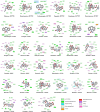Identification and In-Silico study of non-synonymous functional SNPs in the human SCN9A gene
- PMID: 38394191
- PMCID: PMC10889873
- DOI: 10.1371/journal.pone.0297367
Identification and In-Silico study of non-synonymous functional SNPs in the human SCN9A gene
Erratum in
-
Correction: Identification and In-Silico study of non-synonymous functional SNPs in the human SCN9A gene.PLoS One. 2024 Mar 26;19(3):e0301489. doi: 10.1371/journal.pone.0301489. eCollection 2024. PLoS One. 2024. PMID: 38530842 Free PMC article.
Abstract
Single nucleotide polymorphisms are the most common form of DNA alterations at the level of a single nucleotide in the genomic sequence. Genome-wide association studies (GWAS) were carried to identify potential risk genes or genomic regions by screening for SNPs associated with disease. Recent studies have shown that SCN9A comprises the NaV1.7 subunit, Na+ channels have a gene encoding of 1988 amino acids arranged into 4 domains, all with 6 transmembrane regions, and are mainly found in dorsal root ganglion (DRG) neurons and sympathetic ganglion neurons. Multiple forms of acute hypersensitivity conditions, such as primary erythermalgia, congenital analgesia, and paroxysmal pain syndrome have been linked to polymorphisms in the SCN9A gene. Under this study, we utilized a variety of computational tools to explore out nsSNPs that are potentially damaging to heath by modifying the structure or activity of the SCN9A protein. Over 14 potentially damaging and disease-causing nsSNPs (E1889D, L1802P, F1782V, D1778N, C1370Y, V1311M, Y1248H, F1237L, M936V, I929T, V877E, D743Y, C710W, D623H) were identified by a variety of algorithms, including SNPnexus, SNAP-2, PANTHER, PhD-SNP, SNP & GO, I-Mutant, and ConSurf. Homology modeling, structure validation, and protein-ligand interactions also were performed to confirm 5 notable substitutions (L1802P, F1782V, D1778N, V1311M, and M936V). Such nsSNPs may become the center of further studies into a variety of disorders brought by SCN9A dysfunction. Using in-silico strategies for assessing SCN9A genetic variations will aid in organizing large-scale investigations and developing targeted therapeutics for disorders linked to these variations.
Copyright: © 2024 Waheed et al. This is an open access article distributed under the terms of the Creative Commons Attribution License, which permits unrestricted use, distribution, and reproduction in any medium, provided the original author and source are credited.
Conflict of interest statement
The authors have declared that no competing interests exist.
Figures






References
-
- Parine N.R., Genetic polymorphisms. 2017: BoD–Books on Demand.
-
- Teama S., DNA polymorphisms: DNA-based molecular markers and their application in medicine. Genetic Diversity and Disease Susceptibility, 2018. 25.
MeSH terms
Substances
LinkOut - more resources
Full Text Sources
Molecular Biology Databases

